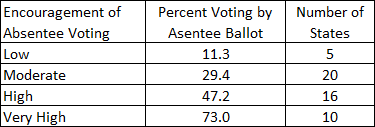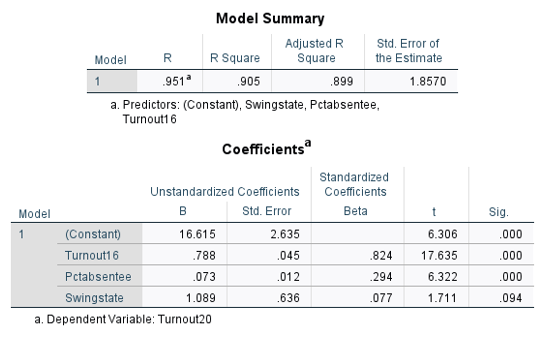Assessing the Impact of Absentee Voting on Turnout and Democratic Vote Margin in 2020
A Commentary By Alan I. Abramowitz
KEY POINTS FROM THIS ARTICLE
— While the 2020 presidential election saw a record volume of absentee votes cast, not all states made it equally accessible.
— Eased absentee voting rules contributed to higher voter participation rates.
— With higher turnout, President Joe Biden’s performance still tracked closely with Hillary Clinton’s state-by-state results in 2016 — he just performed slightly better across the board.
— All told, the sharp increase in absentee voting in 2020 wasn’t disproportionately beneficial to either presidential candidate.
Examining the electoral consequences of 2020’s absentee vote
The 2020 presidential election was remarkable in many respects. First and foremost, despite taking place in the midst of a deadly pandemic that would result in the deaths of hundreds of thousands of Americans, the 2020 election resulted in the highest rate of turnout in over a century. According to Michael McDonald of the University of Florida, 159.7 million Americans cast ballots in 2020 — an increase of roughly 20 million over the 2016 presidential election. The estimated 66.7% turnout of eligible voters easily eclipsed the post-World War II record of 63.8% set in 1960.
According to many observers, one of the key factors contributing to the record turnout in 2020 was a dramatic increase in the availability of absentee voting in many states. Liberalized absentee voting rules made it possible for millions of Americans to fill out their ballots at home and place them in a mailbox or a drop-box rather than risking exposure to the deadly coronavirus by voting in person. According to a survey of over 18,000 registered voters conducted by MIT political scientist Charles Stewart III, between 2016 and 2020, the percentage of votes cast by absentee ballot in the United States increased from 21% to 46%.
Table 1: Percentage voting by absentee ballot by state absentee voting rules
Notes: Low = absentee voting requires valid excuse; Moderate = anyone can vote absentee but nothing mailed automatically to voters; High = anyone can vote absentee and absentee ballot application mailed automatically to all voters; Very High = anyone can vote absentee and absentee ballot mailed automatically to all voters.
Sources: U.S. Elections Project and FiveThirtyEight.
The data in Table 1 show that there was a strong relationship between the prevalence of absentee voting and the rules governing absentee voting in the states. I divided states into four categories based on how easy or difficult they made it for voters to cast absentee ballots. Despite the coronavirus pandemic, five states continued to require a valid excuse for absentee voting such as being over 70 or 75 years of age, temporary out-of-state residence, or a permanent disability. Fear of exposure to coronavirus was not considered a valid excuse in these states. As a result, an average of only 11% of voters cast absentee ballots in those states. In contrast, 10 states allowed no-excuses absentee voting and automatically mailed ballots to all voters. In those states, an average of 73% of voters cast absentee ballots.
In this study, I address two questions about the impact of expanded absentee voting on the 2020 election. First, to what extent did it lead to higher turnout, as its proponents hoped? Second, did it benefit the Democratic presidential candidate, Joe Biden, as President Trump and other Republican critics of absentee voting frequently alleged? There is no evidence to support claims by Trump and his political allies that absentee voting resulted in widespread fraud. However, there is considerable evidence that Democratic voters were much more likely to take advantage of absentee voting in 2020 than Republican voters — in part, because President Trump frequently attacked the legitimacy of absentee voting, thereby discouraging its use by his supporters.
Table 2: Correlations of absentee voting with change in turnout and change in Democratic vote margin in the states
Sources: U.S. Elections Project and Dave Leip’s Atlas of U.S. Presidential Elections.
Table 2 displays correlations between the prevalence of absentee voting in 2020 and changes in turnout and in Democratic vote margin between 2016 and 2020 across all 50 states and the District of Columbia. The results show that there was a strong and statistically significant correlation between the prevalence of absentee voting and increased voter turnout in 2020. States with higher rates of absentee voting generally experienced larger increases in turnout than those with lower rates of absentee voting. On the other hand, the results show that there was no relationship at all between the prevalence of absentee voting and changes in Democratic vote margin between 2016 and 2020. States with high rates of absentee voting did not see larger increases in Democratic vote margins between these two elections than states with low rates of absentee voting.
In order to provide more definitive tests of the effects of absentee voting on turnout and Democratic vote margins, I conducted two regression analyses. The first regression analysis examined the impact of absentee voting on 2020 turnout while controlling for 2016 turnout and a dummy variable indicating whether a state was a swing state in 2020. This was based on the hypothesis that turnout would be higher in hotly contested states than in other states due to greater efforts by the campaigns to mobilize voters in those states. The states that are defined as “swing states” for Table 3 are Arizona, Florida, Georgia, Iowa, Michigan, North Carolina, Nevada, Ohio, Pennsylvania, Texas, and Wisconsin. The second regression analysis examined the impact of absentee voting on the 2020 Biden vote margin while controlling for the 2016 Clinton vote margin. The results of these two regression analyses are presented in Tables 3 and 4.
Table 3: Regression analysis of voter turnout in the states
Table 4: Regression analysis of Biden margin in the states
Sources: U.S. Elections Project and Dave Leip’s Atlas of U.S. Presidential Elections.
The results displayed in Table 3 show that this simple regression model explains about 90% of the variation in 2020 turnout across all 50 states and the District of Columbia. By far the strongest predictor of 2020 turnout is 2016 turnout. There is a great deal of continuity in relative turnout among states over these four years — states with relatively high rates of turnout in 2016 tended to have relatively high rates of turnout in 2020 and states with relatively low rates of turnout in 2016 tended to have relatively low rates of turnout in 2020. However, after controlling for 2016 turnout and swing state status, the prevalence of absentee voting in 2020 had a moderately strong and statistically significant impact on turnout in 2020. According to these results, an increase of 10 percentage points in the prevalence of absentee voting in a state would have increased turnout by a little more than 0.7 percentage points.
In contrast, the results displayed in Table 4 indicate that the prevalence of absentee voting had no effect on Joe Biden’s vote margin in 2020. The regression model explains almost 99% of the variance in Biden’s vote margin, but that is due entirely to the powerful effect of 2016 Clinton vote margin. Just adding three points to Clinton’s margin turned out to be an excellent predictor of Biden’s vote margin in the states. Whether a state had a relatively high or relatively low rate of absentee voting had no effect on Biden’s vote margin after controlling for Clinton’s vote margin.
Conclusions
The evidence presented in this study leads to two clear conclusions. First, the dramatic increase in absentee voting in 2020 contributed to increased voter turnout. Even after controlling for 2016 turnout and swing state status, the prevalence of absentee voting in a state was a significant predictor of turnout in 2020. Eased absentee voting rules were not the only reason for increased turnout in 2020, but they did make a difference. Second, increased absentee voting did not favor Joe Biden’s candidacy. After controlling for 2016 Democratic vote margin, the prevalence of absentee voting in a state had no effect at all on 2020 Democratic vote margin.
These findings suggest that efforts by Republican legislators in a number of states to roll back eased absentee voting rules and make it more difficult for voters to take advantage of absentee voting in the future are unlikely to benefit GOP candidates. Not only is there no evidence that absentee voting leads to widespread fraud, there is also no evidence that it favors Democratic candidates.
Alan I. Abramowitz is the Alben W. Barkley Professor of Political Science at Emory University and a senior columnist with Sabato’s Crystal Ball. His latest book, The Great Alignment: Race, Party Transformation, and the Rise of Donald Trump, was released in 2018 by Yale University Press. |
See Other Commentary by Dr. Alan Abramowitz.
See Other Political Commentary.
This article is reprinted from Sabato's Crystal Ball.
Views expressed in this column are those of the author, not those of Rasmussen Reports. Comments about this content should be directed to the author or syndicate.
Rasmussen Reports is a media company specializing in the collection, publication and distribution of public opinion information.
We conduct public opinion polls on a variety of topics to inform our audience on events in the news and other topics of interest. To ensure editorial control and independence, we pay for the polls ourselves and generate revenue through the sale of subscriptions, sponsorships, and advertising. Nightly polling on politics, business and lifestyle topics provides the content to update the Rasmussen Reports web site many times each day. If it's in the news, it's in our polls. Additionally, the data drives a daily update newsletter and various media outlets across the country.
Some information, including the Rasmussen Reports daily Presidential Tracking Poll and commentaries are available for free to the general public. Subscriptions are available for $4.95 a month or 34.95 a year that provide subscribers with exclusive access to more than 20 stories per week on upcoming elections, consumer confidence, and issues that affect us all. For those who are really into the numbers, Platinum Members can review demographic crosstabs and a full history of our data.
To learn more about our methodology, click here.





